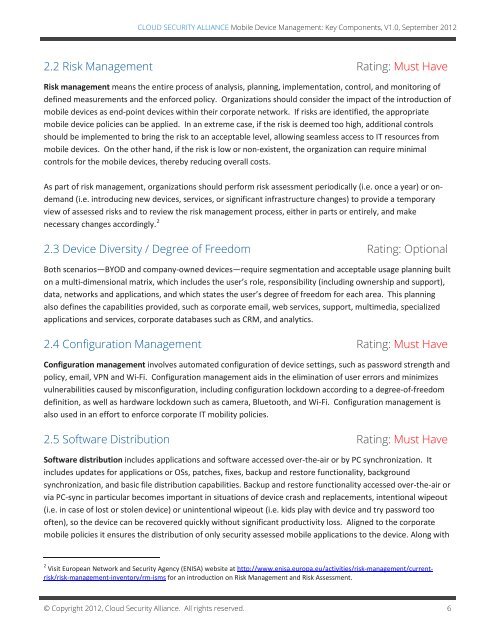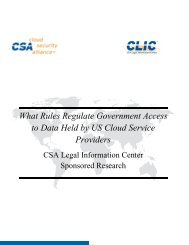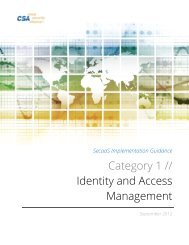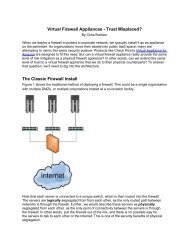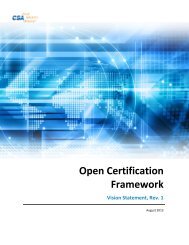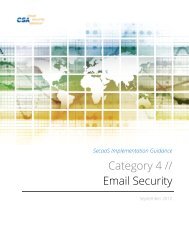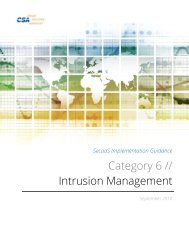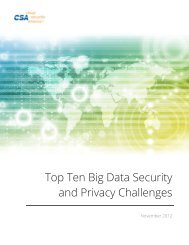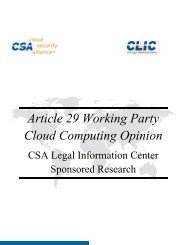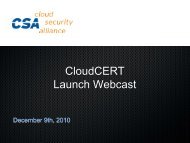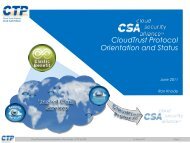Mobile Device Management: Key Components, V1.0
Mobile Device Management: Key Components, V1.0
Mobile Device Management: Key Components, V1.0
- No tags were found...
Create successful ePaper yourself
Turn your PDF publications into a flip-book with our unique Google optimized e-Paper software.
CLOUD SECURITY ALLIANCE <strong>Mobile</strong> <strong>Device</strong> <strong>Management</strong>: <strong>Key</strong> <strong>Components</strong>, <strong>V1.0</strong>, September 20122.2 Risk <strong>Management</strong> Rating: Must HaveRisk management means the entire process of analysis, planning, implementation, control, and monitoring ofdefined measurements and the enforced policy. Organizations should consider the impact of the introduction ofmobile devices as end-point devices within their corporate network. If risks are identified, the appropriatemobile device policies can be applied. In an extreme case, if the risk is deemed too high, additional controlsshould be implemented to bring the risk to an acceptable level, allowing seamless access to IT resources frommobile devices. On the other hand, if the risk is low or non-existent, the organization can require minimalcontrols for the mobile devices, thereby reducing overall costs.As part of risk management, organizations should perform risk assessment periodically (i.e. once a year) or ondemand(i.e. introducing new devices, services, or significant infrastructure changes) to provide a temporaryview of assessed risks and to review the risk management process, either in parts or entirely, and makenecessary changes accordingly. 22.3 <strong>Device</strong> Diversity / Degree of Freedom Rating: OptionalBoth scenarios—BYOD and company-owned devices—require segmentation and acceptable usage planning builton a multi-dimensional matrix, which includes the user’s role, responsibility (including ownership and support),data, networks and applications, and which states the user’s degree of freedom for each area. This planningalso defines the capabilities provided, such as corporate email, web services, support, multimedia, specializedapplications and services, corporate databases such as CRM, and analytics.2.4 Configuration <strong>Management</strong> Rating: Must HaveConfiguration management involves automated configuration of device settings, such as password strength andpolicy, email, VPN and Wi-Fi. Configuration management aids in the elimination of user errors and minimizesvulnerabilities caused by misconfiguration, including configuration lockdown according to a degree-of-freedomdefinition, as well as hardware lockdown such as camera, Bluetooth, and Wi-Fi. Configuration management isalso used in an effort to enforce corporate IT mobility policies.2.5 Software Distribution Rating: Must HaveSoftware distribution includes applications and software accessed over-the-air or by PC synchronization. Itincludes updates for applications or OSs, patches, fixes, backup and restore functionality, backgroundsynchronization, and basic file distribution capabilities. Backup and restore functionality accessed over-the-air orvia PC-sync in particular becomes important in situations of device crash and replacements, intentional wipeout(i.e. in case of lost or stolen device) or unintentional wipeout (i.e. kids play with device and try password toooften), so the device can be recovered quickly without significant productivity loss. Aligned to the corporatemobile policies it ensures the distribution of only security assessed mobile applications to the device. Along with2 Visit European Network and Security Agency (ENISA) website at http://www.enisa.europa.eu/activities/risk-management/currentrisk/risk-management-inventory/rm-ismsfor an introduction on Risk <strong>Management</strong> and Risk Assessment.© Copyright 2012, Cloud Security Alliance. All rights reserved. 6


